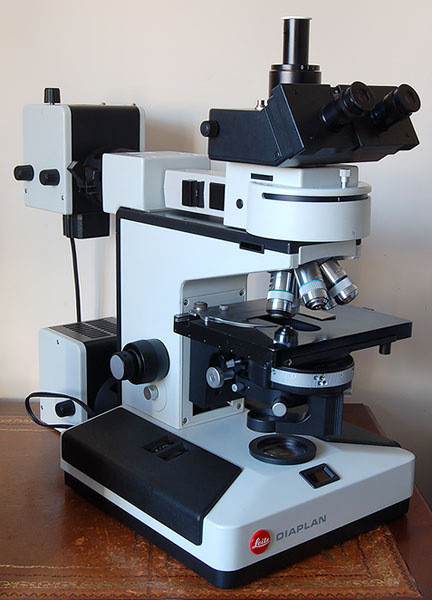
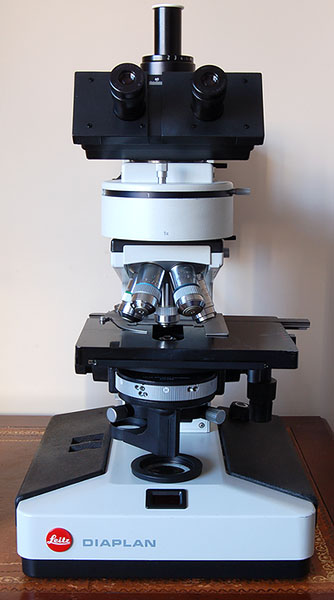
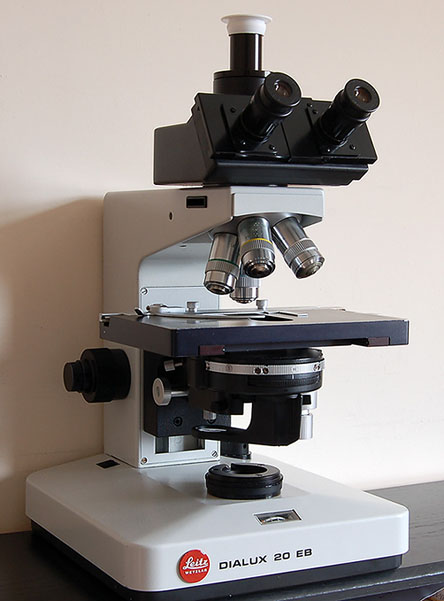
A tour round a Leitz Diaplan microscope
by David Walker, UK
Update: Willem Steurbaut has very kindly shared a Leitz brochure and Leitz article on the Diaplan which answer many of the questions posed in the article below. These can be downloaded at this link.
Updated June 2009. English Diaplan manual in pdf format can be downloaded here, courtesy of Willem Steurbaut.
Updated October 2010. Cautionary tale for potential purchasers - ask seller to check the coarse focus rack before purchase and suggested safe packing methods. See footnote.
Updated August 9th 2019 with careful tests kindly carried by Stephen Thorpe on the compatibility of components in the Leitz range with the Diaplan.
The Diaplan was apparently a model introduced by Leitz in 1985, fitting in between their typical 'laboratory' models (e.g. Dialux) and the 1986 flagship model, the Aristoplan (ref. 1). Although there are a range of manuals and resources available online for other models of this era, there seems a dearth of resources on the Diaplan. The author and his brother acquired and share a Diaplan with a Ploemopak head for fluorescence studies but have drawn a complete blank on acquiring brochures, manuals or system diagrams (Leica UK to date have not replied to queries).
There are a number of interesting features on the Diaplan, so below is offered a hands-on tour of the microscope. Queries on some aspects are raised in the hope it may prompt a reader or fellow user who has access to, or knowledge of, resources on the Diaplan to come forward. We know of at least two other enthusiast Diaplan owners seeking information.



Leitz Diaplan, left
and middle,
shown here with Ploemopak epi-fluorescence head.
Compared with a previously
owned Leitz Dialux
20EB, right. Note the Diaplan's extra depth of base and limb and wider field
lens.
Stand design - condenser
iris in base, lamp voltage display
The base is a little deeper than
the Dialux as it encloses both the transmitted lamp electronics and
the large diameter field optics / irises. The field lens on the base is considerable
wider (ca. 50 mm) than e.g the Dialux. The limb
is also deeper to give a more robust rather than elegant looking stand. Two soft hand rests are
on the base which gives a comfortable feel. Although high up the model range,
I wouldn't say the fit and finish was superior, if anything a little more plasticky
in places compared with e.g. a Dialux 20 used previously.
An intriguing feature is the inclusion of both field iris and condenser iris in the base; the latter is furthest from the field lens. Two knurled control knobs are coupled by rubber belts to the irises. It would be interesting to see a Leitz brochure to find out how this feature was marketed. There's arguably a slight ergonomic benefit but perhaps Leitz were also trying to be different to distinguish it in the marketplace. Rost in ref. 1 notes it was the first microscope to his knowledge to have this design.
Focus - upper limit
control
A feature I don't recall seeing on other Leitz models of this
era is the option to set a coarse / fine focus limit using the knob below lefthand
focus knob. The only slight disadvantage
on this example at least, is that if not used, the mechanics of this feature causes
some clicking
when using the focus.
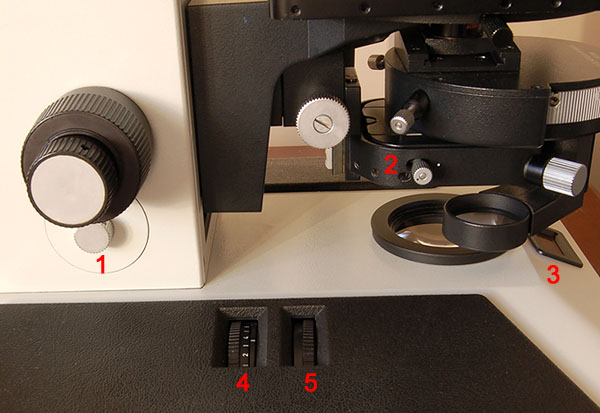
Some features
of the Diaplan:
1 - Knob sets upper focus limit of stage. Turn left
(as shown from this view), releases to adjust; turn right,
sets upper
limit at current stage focus setting.
2 - Knob to lock and release
the condenser in the dovetail fitting.
3 - Red LED voltage panel
showing lamp output to 0.5V steps (for the original unit).
4 - Aperture iris control (usually found
on condenser). Numbered 1 - 9 plus 'PH' phase setting.
5 - Field
iris control.
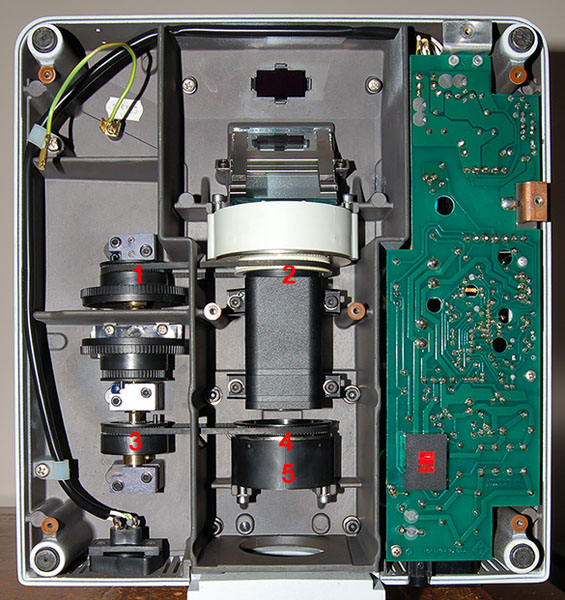
Diaplan
underside with sturdy fitted metal base removed. (LED voltage display
module not installed, requires replacement).
1 and 2 - field
iris control knob and diaphragm driven by rubber belt.
3 and
4 - aperture iris control knob and diaphragm driven by rubber
belt.
5 - ground glass diffuser permanently installed.
The
switched mode power supply for the transmitted light source is on
the right.
At the front is a red digital display of the lamp voltage output, and useful for repeatable light settings. The module may have failed at some time in this example as it has been removed and is not available from Leitz as a spare, but my brother, an electronics engineer, has sourced a component of similar spec from Lascar Electronics to retrofit. The replacement displays in 0.1V steps (thank you to other owners who tell me that the original displayed in 0.5V steps); the power supply is stable enough to hold voltage to 0.1V. By inspection the electronics are switched mode, avoiding the resistive heating in the base found in some rheostat controlled models.
The lamp control has a very light action and is just below the focus knobs; from the author's experiences it's quite easy to inadvertently knock the lamp intensity setting when using the focus.
Stage - rectangular
design with rotation
This example has a rectangular
mechanical stage with drop down x/y controls fitted as standard, but it fully
rotates
with detent at 90 degrees. The rotation is released with a locking screw on left below stage and stage
is turned using knob
on front right (to avoid changing x/y stage setting). The x and y graduations have a range marked in red to indicate
the range to keep within to ensure the stage doesn't hit the back
of limb if rotated.
Rotation is a very useful feature where subject orientation is important e.g. for oblique, polar and DIC, as a circular rotating stage usually loses the ergonomic drop down x/y controls, whereas this design retains them. Quantitative polar work would of course require a graduated stage.
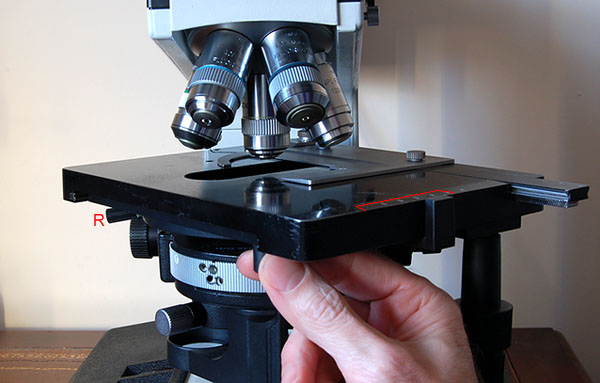
Rotating stage,
using under stage knob. 'R' is the rotation release knob.
The red range marked
on x/y graduations has been emphasised.
Lighting - transmitted
The standard lamphouse
for the Diaplan is a simple design with just a focussing control for the field
lens; by inspecting images of other Diaplans online this appears to be the standard
lamphouse. A diffuser (with a fine mottled rather than ground glass finish)
is permanently fitted in the lamp and there's a
second ground glass diffuser in the base field optics. The benefit
of this design is that it avoids the alignment of lamp and mirror image with
the multi-controls seen on e.g. a Leitz Dialux 20 lamphouse, but the downside
is the light loss of two diffusers.
For optical purists, true Köhler is not possible, unlike some Leitz stands like the Dialux 20 with external lamphouse. This fixed diffuser design is commonly seen in many makers' modern lab stands (e.g Nikon Labophot) but perhaps surprising in a model one down from Leitz's flagship; perhaps this design was related to the aperture iris in base and/or large diameter field optics.
This example was supplied with Periplan GF 10X/18M eyepieces (i.e field no. 18) and standard trino' head with 23 mm eyepiece tubes. But from a seller's description of a Diaplan recently sold on eBay, the Diaplan was apparently capable of widefield viewing with a field number up to 28 with a widefield GW trinocular head and 30 mm 'widefield GW 10X/26M' eyepieces (ie field no. 26 mm).
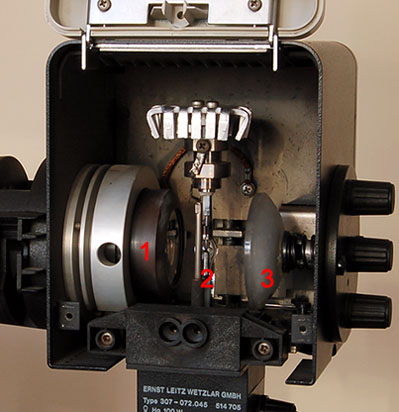
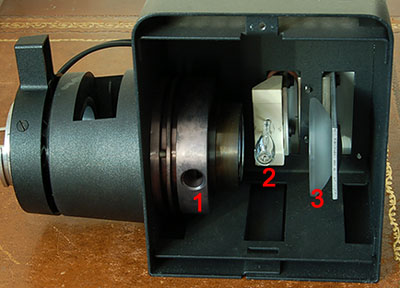
Left:
Epi-fluorescence 100 W mercury arc lamp housing. 1 - focussing lens,
2 - vertical arc lamp with heat sink, 3 - adjustable rear mirror.
Right:
Transmitted lamphouse for Diaplan. The only lamphouse control is
the lens focus 1 (fixed diffuser to left of these optics). 2 - halogen bulb, 3 - fixed non adjustable
rear mirror.
Lighting - epi-fluorescence
This
stand came supplied with the Ploemopak with blue, green, UV filter blocks and
100W mercury lamp. The lamp fitting is the same as for the transmitted so the halogen lamp can be
used for green or blue excitation epi-fluorescence with suitable
subjects. With this Leitz Ploemopak
add-on design, the eyepiece height is increased, unlike the equivalent accessory
on the Orthoplan or Zeiss Photomicroscope.
Optics 160 mm, with
some useful Zeiss compatibility
The stand was designed for and came supplied
with 160 mm Leitz objectives and the Universal condenser for brightfield, phase and darkfield. I
also often use dry Zeiss 160 mm objectives on the stand. A useful
coincidence is that the '2' phase ring on the Leitz condenser is a perfect match*
without refocussing with the Zeiss phase '2' objectives, ie 16x - 40x. The '4'
darkfield setting on Leitz condenser with slight refocussing is a good
match*
with the '3' phase ring on Zeiss immersion objectives (e.g. the 100x/1,3 Neofluar
phase). The '5' ring also gives excellent COL (annular lighting) with a Zeiss
16x objective and useful when scanning pond life samples.
*These matches are for the Universal condenser designed for the Diaplan, which has no iris. I'm uncertain if the same match applies to the Universal condenser with iris supplied with other Leitz stands of this era, although this example does use the standard condenser top optics, in this case the 'ACHR NA0.9 S1.1'.
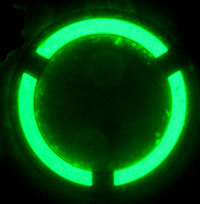
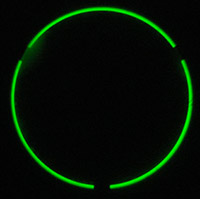
Left: A Zeiss Ph2
objective (in this case a 16X/0.45 Neofluar) is a good match with '2' ring
on Leitz condenser for phase work.
Right: Same objective with Leitz condenser
'5' setting gives good COL.
Both with 'ACHR NA0.9 S1.1
dry condenser top element.
Component interchange
across Leitz range?
Modularity is often a key selling point of this type
of stand, but without access to any brochures or system diagrams I'm uncertain
what range of accessories were specific to the Diaplan (and Aristoplan?)
and what were shared with other stands of this era like the Dialux. The
trinocular / Ploemopak head and objective nosepiece seem to have the standard
fittings. The condenser
dovetail mount is 47.5 mm at widest point which seems close to that stated in
adverts for condensers for other Leitz models of this era. I'm uncertain,
whether other than the lack of iris, the optics of condensers for other Leitz
models of this era
will also work on the Diaplan. Comments welcomed.
Note added Jan. 12th:
Thank you to a correspondent and a former Diaplan owner who tells
me that a Universal condenser for Dialux 20 is not compatible with the Diaplan
including the phase rings. Neither are the interchangeable top elements.
Note added Aug. 9th 2019, see Appendix for tests by Stephen Thorpe.
The stage mountings seem the same as those on a Dialux formerly owned, but don't think the limb would be deep enough on the smaller stands to accept this rotating stage.
Although the more advanced Leitz 100W halogen lamphouse for transmitted work may physically fit, given the large diameter field optics, aperture iris and permanent diffuser in base, I'm not sure if it would work correctly.
General comments
In
use it is a competent, sturdy and workmanlike stand very much like the other
models of this era. The aperture iris in base seems neither a particular benefit
nor hindrance to this user. The mechanical stage with rotation is perhaps the
feature that most appealed.
Note added Jan. 12th: The substage incompatibility with older stands of the era like a Dialux 20 which a correspondent kindly remarked on, may influence a buying decision if considering 'mixing and matching' components.
It's pricing, as this one, can be comparable to lesser specced more popular models, perhaps because of its unfamiliarity, unusual aperture iris design and that resources are hard to find (if not supplied with the microscope). The author would welcome any information or resources on the Diaplan that readers / users may have or know of.
Comments to the author David Walker are welcomed.
Cautionary tale to potential buyers of a Diaplan: Added October 2010. On receipt of my example from a mainland Europe dealer (I live in UK), the stage disengaged and dropped off the coarse focus rack near bottom of the focus travel. After internal inspection, this was caused by stripped teeth on the coarse rack. Discussions with another owner with a similar problem suggests that mine was not a one-off example and advise potential buyers to ask the seller if the coarse focus is smooth throughout its full travel range. If the rack is damaged, sourcing a new one or finding a service agent who has a spare to repair it, may be time intensive and costly.
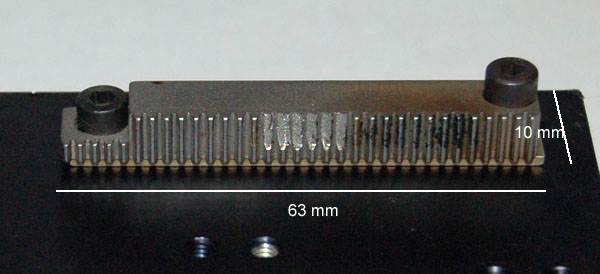
The author's Leitz Diaplan damaged focus rack shown mounted on its support; ball bearings run in channels on both sides of this mount.
The straight cut teeth may make it easier to manufacture if need to seek a maker of one. By inspection the rack and pinion are a loose mesh, it seems to be the weight of the stage acting on top of one or two teeth that provides the focus feel. The rack affects a compass so presumably a steel; I'm not a metallurgist but to my eye the metal structure seems quite porous.
The very heavy stage and condenser may put too much stress on the few teeth on the rack supporting it if the stand is dropped in transit. To minimise this, it is worth asking the seller to remove the condenser and to coarse focus fully down onto a stiff foam pad underneath the focus block. To be totally safe the stage can be removed to take all weight off the rack, it's held by three Allen nuts, although to remove the centre nut the condenser support also has to be removed; possibly too much to ask for many sellers. Also there may be a thin shim under one nut of the stage, which must be noted and retained.
The dealer I bought mine off managed to source what may have been the last spare focus rack in Europe. To avoid high overseas shipping I installed it myself but it was tricky; the ball bearings on the focus slide are not captive, the optical axis has to be carefully reestablished and requires care in choice of grease and reinstallation of mechanism to restore the original fine focus feel. A US owner did not manage to source a rack for his damaged Diaplan and had to have two spares made up at some expense (ca. $200 for two). (Thank you to the fellow Diaplan owner for sharing his experiences; combined with mine shared above, hopefully this may avoid further damage to these splendid stands.)
Appendix: Added Aug. 9th 2019. Notes on the compatability of various components kindly supplied by Stephen Thorpe.
Tested:
Leitz Diaplan, FSA OT (observation tube) with Periplan GW 8x/28 goggles M oculars, lamp-house 307-148.001, 1x (no tube lens) nose-piece, UKO condenser with ICT turret.
Leitz Dialux 20 with FSA OT with Periplan 10x/18 goggles M oculars, lamp-house 307-143.003, 1x nose-piece, UK condenser with phase turret.
100Z lamp-house with reducing adapter to small bayonet fitting. 2.5x plan achromat, 10x Pl Fluotar, , 25x Pl Apochromat, and 40x Pl Fluotar.
Limitations of test: Impressions of evenness of illumination are just that - impressions. A more critical test would be photography; the 1x nose-piece restricts the measured FOV to 22 (0.89 mm with a 25x objective). These results may not apply to a wider field of view using the 0.8x nose-piece.
1) All three lamp-houses are usable on either frame but the Dialux needs to be lifted to accommodate the extra depth of the two wide-field lamp-houses.
2) The condensers are interchangeable but with the UK condenser on the Diaplan it is impossible to raise the condenser enough to form a completely sharp image of the field diaphragm with the top condenser lens swung out although illumination appears to be even.
3) Using the UKO condenser on the Dialux means there is no available aperture diaphragm but if you are using only phase contrast you will not mind.
4) Aperture diaphragms (both) work as anticipated.
5) Putting the wide-field OT on the Dialux gives an FOV of 22 and contra-wise 18. No loss of par-focality when OT's are switched.
6) The UK condenser has a shorter working distance and inferior chromatic correction on both stands.
7) From 'The DIAPLAN a new LEITZ microscope' note that Plan achromats have FOV of 20, Pl Fluotars FOV 25 and Pl Apochromats a FOV of 28.
8) Turrets can be removed using a 9.5 mm x 1 mm screwdriver which you will probably need to grind yourself. They are not compatible. The ICT prisms in the UKO turret are factory fixed and can not be removed or adjusted.
9) Phase rings S 1.1 from the UK condenser were removed using a 2 mm hex key on two screws which act against a spring loaded plunger. When installed in the UKO condenser the rings for phase 1 and 2 are not compatible.
Reference
1) F W
D Rost, 'Fluorescence microscopy', vol. 1, CUP 1992, p. 65. The
author discusses fluorescence microscopes by some major makers; for Leitz models
these include the Aristoplan, Diaplan and Laborlux S fitted out for epi-fluorescence,
also the Fluovert.
A Diaplan with epi-fluorescence is illustrated on p. 66. This Chapter can be
previewed on Google
Books.
Published in the January 2009 edition of Micscape.
Please report any Web problems or offer general comments to the Micscape Editor .
Micscape is the on-line monthly magazine of the Microscopy UK web site at Microscopy-UK
©
Onview.net Ltd, Microscopy-UK, and all contributors 1995
onwards. All rights reserved.
Main site is at
www.microscopy-uk.org.uk
with full mirror
at
www.microscopy-uk.net
.